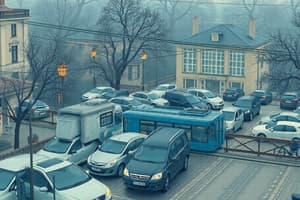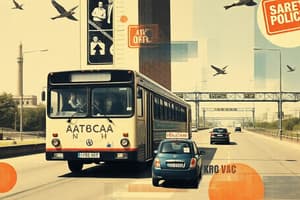Podcast
Questions and Answers
deals with developing a set of constructs and propositions that are established to achieve specific objectives relating to social, economic, and environmental conditions, and the functioning and performance of the transport system.
deals with developing a set of constructs and propositions that are established to achieve specific objectives relating to social, economic, and environmental conditions, and the functioning and performance of the transport system.
deals with the preparation and implementation of actions designed to address specific problems.
deals with the preparation and implementation of actions designed to address specific problems.
increased interactions at the international level, both for freight and passengers.
increased interactions at the international level, both for freight and passengers.
This enabled the transfer of ownership and operation of many transport modes to the private sector and favored the entry of new actors.
This enabled the transfer of ownership and operation of many transport modes to the private sector and favored the entry of new actors.
This has enabled better coordination of investments improving the efficiency of interconnected transportation networks and the related supply chains.
This has enabled better coordination of investments improving the efficiency of interconnected transportation networks and the related supply chains.
The policy process is becoming more responsive to public concerns over environmental externalities and social equity issues.
The policy process is becoming more responsive to public concerns over environmental externalities and social equity issues.
Governments have a large number of instruments at their disposal to carry out transport policies. Some are direct, such as public ownership, but the majority are indirect, such as safety standards.
Governments have a large number of instruments at their disposal to carry out transport policies. Some are direct, such as public ownership, but the majority are indirect, such as safety standards.
full or partial ownership of transportation modes or assets.
full or partial ownership of transportation modes or assets.
funding for transport infrastructure and modes.
funding for transport infrastructure and modes.
technical standards for transport modes and assets.
technical standards for transport modes and assets.
funding research improving the technical, economic and environmental performance of transportation.
funding research improving the technical, economic and environmental performance of transportation.
standards such as certification, working conditions
and compensation and benefits in the transport sector.
standards such as certification, working conditions and compensation and benefits in the transport sector.
operational standards for transport modes and assets, such as speed and weight limits.
operational standards for transport modes and assets, such as speed and weight limits.
Policies are dynamic. They change and evolve as circumstances change and as
new problems are recognized.
Policies are dynamic. They change and evolve as circumstances change and as new problems are recognized.
The dynamic nature of policymaking is reflected in how the policy instruments have
been employed over the years. Historical examples of private transport provision
include:
The dynamic nature of policymaking is reflected in how the policy instruments have been employed over the years. Historical examples of private transport provision include:
The trends in transport policy in recent decades have been toward liberalization
and privatization.
The trends in transport policy in recent decades have been toward liberalization and privatization.
Terminals remain largely under State
or municipal ownership, but concession agreements to private operators
are common.
Terminals remain largely under State or municipal ownership, but concession agreements to private operators are common.
- most significant and
enduring commitments of public funds
- most significant and enduring commitments of public funds
- remain dominantly publicly owned and operated.
- remain dominantly publicly owned and operated.
- Alliances between major carriers,
such as the maritime and air industry, are also sources of contention and
regulatory oversight.
- Alliances between major carriers, such as the maritime and air industry, are also sources of contention and regulatory oversight.
Transport planning usually addresses specific problems or broad transport
concerns at a local level and has been traditionally a preoccupation of lower-tier
governments (state, county, municipal). Because of this fact, transport planning
is most developed in the urban sphere, and it is there where most experience
has been gathered.
Transport planning usually addresses specific problems or broad transport concerns at a local level and has been traditionally a preoccupation of lower-tier governments (state, county, municipal). Because of this fact, transport planning is most developed in the urban sphere, and it is there where most experience has been gathered.
- A high-level long-term planning horizon that relies on
strategic plans implementing a vision.
- A high-level long-term planning horizon that relies on strategic plans implementing a vision.
- Involves both financial and strategic planning, often
reported through business plans
- Involves both financial and strategic planning, often reported through business plans
- Involves decisions solving practical
problems related to transport operations, usually within a year.
- Involves decisions solving practical problems related to transport operations, usually within a year.
- The government or a related authority sets the
strategic goals and prepares plans.
- The government or a related authority sets the strategic goals and prepares plans.
- Stakeholders such as carriers and operators are the
main drivers of the planning process by providing actionable input.
- Stakeholders such as carriers and operators are the main drivers of the planning process by providing actionable input.
- The government or related authority sets the strategic
intent of the planning process and asks stakeholders to propose projects
supporting the main goals.
- The government or related authority sets the strategic intent of the planning process and asks stakeholders to propose projects supporting the main goals.
Planning is commonly scale-specific and multidimensional. In cities, traffic
problems have increased significantly since the 1970s, despite a great deal of
urban transport planning.
Planning is commonly scale-specific and multidimensional. In cities, traffic problems have increased significantly since the 1970s, despite a great deal of urban transport planning.
Planning is still a multi-step process, but it has changed considerably:
Planning is still a multi-step process, but it has changed considerably:
Managing the demand for transport is made up of a large number of small
interventions that cumulatively can impact demand but, in particular, improve the
livability of cities.
Managing the demand for transport is made up of a large number of small interventions that cumulatively can impact demand but, in particular, improve the livability of cities.
A sample of well-practiced and successful interventions includes:
A sample of well-practiced and successful interventions includes:
The governance of transport infrastructure is particularly relevant because of
its strategic, economic, and social importance and the cross-jurisdictional
character of many infrastructures, such as highways, rail, and telecommunication
networks
The governance of transport infrastructure is particularly relevant because of its strategic, economic, and social importance and the cross-jurisdictional character of many infrastructures, such as highways, rail, and telecommunication networks
- It provides confidence that an activity, such as a terminal, a
transit system, or a logistics zone, is effectively managed.
- It provides confidence that an activity, such as a terminal, a transit system, or a logistics zone, is effectively managed.
- Lowers capital costs as investors and financial institutions
have confidence that the allocated capital will be effectively used to develop
and expand productive assets, generating returns.
- Lowers capital costs as investors and financial institutions have confidence that the allocated capital will be effectively used to develop and expand productive assets, generating returns.
- Improves the capability to compete through the
retention of existing users and the attraction of new ones.
- Improves the capability to compete through the retention of existing users and the attraction of new ones.
- It confers long-term resilience in the organization, providing
stability in capital markets and the financial institutions supporting them.
- It confers long-term resilience in the organization, providing stability in capital markets and the financial institutions supporting them.
There are two main components of transport governance;
There are two main components of transport governance;
Common because of the economic and strategic
importance of many terminals.
Common because of the economic and strategic importance of many terminals.
- Less evident in transport terminals, but there are
numerous exceptions for specific modes.
- Less evident in transport terminals, but there are numerous exceptions for specific modes.
involve the day-to-day management and carrying out of terminal
activities
involve the day-to-day management and carrying out of terminal activities
- This is typical in many ports, state-controlled railroads, and
publicly-owned airports.
- This is typical in many ports, state-controlled railroads, and publicly-owned airports.
Manage and carry out operations in privately owned
terminals.
Manage and carry out operations in privately owned terminals.
provides the basis for transportation planning.
provides the basis for transportation planning.
is a process of finding feasible alternatives and components of a transportation
system to support human activities in a community.
is a process of finding feasible alternatives and components of a transportation system to support human activities in a community.
is a broad category which includes air, water, and
land transportation systems.
is a broad category which includes air, water, and land transportation systems.
Flashcards are hidden until you start studying




